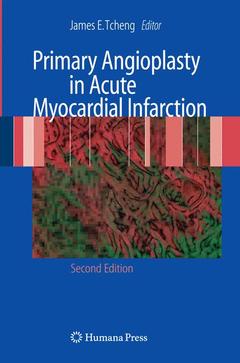Description
Primary Angioplasty in Acute Myocardial Infarction (2nd Ed., Softcover reprint of hardcover 2nd ed. 2009)
Contemporary Cardiology Series
Coordinator: Tcheng James E.
Language: English
Subjects for Primary Angioplasty in Acute Myocardial Infarction:
Primary Angioplasty in Acute Myocardial Infarction (2nd Ed.)
Publication date: 11-2010
225 p. · 15.5x23.5 cm · Paperback
Publication date: 11-2010
225 p. · 15.5x23.5 cm · Paperback
Primary Angioplasty in Acute Myocardial Infarction (2nd Ed.)
Publication date: 12-2008
225 p. · 15.5x23.5 cm · Hardback
Publication date: 12-2008
225 p. · 15.5x23.5 cm · Hardback
Description
/li>Contents
/li>Comment
/li>
The past 50 years have witnessed a breathtaking evolution in the approaches to the patient with an acute ST elevation myocardial infarction. In the 1960s, the now commonplace cardiac intensive care unit was but a nascent idea. Without much to offer the patient but weeks of absolute bedrest, substantial morbidity and high rates of mortality were the norm. Just 30 years ago, seminal discoveries by DeWood and colleagues suggested that the culprit was plaque rupture with thrombosis, not progressive luminal compromise. Subsequent fibrinolyt- based strategies resulted in a halving of the mortality of acute myocardial infarction. With the introduction of balloon angioplasty in the late 1970s, a few interventional cardiologists braved the question: why not perform emergency angioplasty as a primary reperfusion strategy? Indeed, reports of successful reperfusion via balloon angioplasty appeared (mostly in local newspapers) as early as 1980. Despite being thought of as heretical by mainstream cardiology, these pioneers nonetheless persevered, proving the benefit of ??state-of-the-art?? balloon angioplasty compared with ??state-of-t- art?? thrombolytic therapy in a series of landmark trials published in the New England Journal of Medicine in March of 1993. Publication of the first edition of Primary Angioplasty in Acute Myocardial Infarction in 2002 to some extent anticipated the widespread acceptance of primary percutaneous coronary intervention as the standard of care. Since then, in all respects, the evolution of emergency percutaneous revascularization has only accelerated. The universal replacement of balloon angioplasty with stent implantation was clearly one key.
Overview, Rationale, and Lexicon: Primary Percutaneous Coronary Intervention in Acute Myocardial Infarction.- Comparison of Reperfusion Strategies for ST Elevation Acute Myocardial Infarction: Primary Coronary Intervention Versus Fibrinolysis.- Operator and Site Requirements for Primary Coronary Intervention.- Primary Coronary Intervention: The Technical Approach.- Primary Coronary Intervention in Community Hospitals with Off-Site Cardiac Surgery Backup: Rationale and Steps to Quality.- Reducing System and Process Barriers: The RACE to Improve Door to Balloon Performance.- Rescue Coronary Intervention for Failed Thrombolysis.- Facilitated Percutaneous Coronary Intervention.- Therapies Targeted at Preserving Microvascular Integrity and Preventing Reperfusion Injury.- Platelet Glycoprotein IIb/IIIa Receptor Blockade in Primary Coronary Intervention.- Cell Therapy in Acute Myocardial Infarction.- Health Economics of Primary PCI.
Requisite fundamentals for any primary angioplasty program The latest concepts and information Tackles the complexities of reducing door to balloon time Covers options available to primary care hospitals without surgical backup Addresses local and regional system and process-related barriers to reperfusion
© 2024 LAVOISIER S.A.S.




